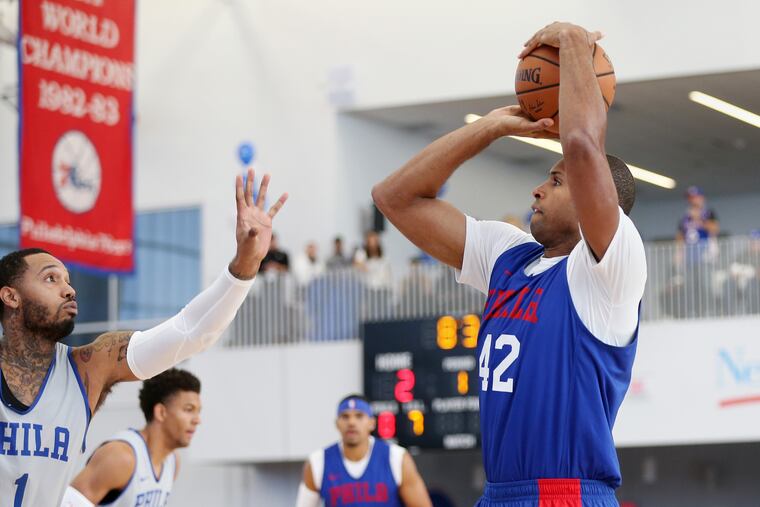Can Al Horford replace JJ Redick for the Sixers? It’s not as crazy as it sounds. | David Murphy
The big man's ability to shoot from three-point range should help to open up space underneath the basket for Joel Embiid.

In one sense, Joel Embiid’s dunk in the first quarter on Tuesday night was a demonstration of the immense physical advantage the Sixers held over their Chinese opponent. Facing up Zheng Zhun outside the left block, Embiid froze the Guangzhou 7-footer with a shoulder fake left and then exploded to his right so fast that his opponent’s feet were still rooted to the court by the time Embiid was past him. Embiid finished the play with an emphatic two-handed flush and drew the foul, and the Sixers were off to a laugher of a win.
While it is difficult to draw any hard conclusions from a game that featured such a disparity in talent, there was at least one notable thing about the play. As Embiid squared up on the left side of the basket before making his move, all that stood between him and the rim was that one defender. The two defenders who were in the best position to offer some sort of weakside help were both preoccupied with a couple of Sixers were spotting up behind the three-point line: Tobias Harris in the opposite corner, and Al Horford above the opposite break.
It was the exact sort of conundrum that the Sixers hope will continue to confound opposing defenses even when the court is filled with NBA-caliber players. After Elton Brand remade his roster in the offseason, one of the big questions facing the Sixers centered on their ability to create enough space on the court for their scorers to operate. Over the previous two seasons, JJ Redick had filled a vital role with his ability to knock down shots from anywhere inside the halfcourt line. During that stretch, the veteran guard averaged 7.3 three-point attempts per game and connected on 40.7%. Without having to account for Redick, the thinking went, defenses would be better able to pack the paint against Embiid and point guard Ben Simmons.
Thus far, that has not been the case, either in the two exhibitions, or in the daily practice runs at the Sixers’ training facility.
“Obviously [against Guangzhou], we played a team that’s not an NBA team,” said Harris, a .405 shooter from three-point range over the last two seasons. “But we’ve seen those looks in practice. Teams are going to have to choose where they want to play and where they want to overhelp, so there’s going to be a lot of openings throughout the year.”
The key variable in all of this is Horford. While the veteran big man has spent the bulk of his career playing center, including the last three seasons in Boston, the Sixers feel his skill set is such that he will be able to do all of the things that Dario Saric did as a stretch-four in Brett Brown’s offense. The frequency with which Horford found himself open behind the three-point line was a conspicuous theme in both Tuesday’s exhibition at the Wells Fargo Center and Saturday’s intrasquad scrimmage in Wilmington. Against Guangzhou, Horford attempted four three-pointers (and made two) in 17 minutes of action, a pace of 8.5 attempts per 36 minutes. Not only is that more than double the highest single-season rate of his career, it’s higher than any that Redick himself has posted in 12 of his 13 NBA seasons.
While nobody expects Horford to transform into a volume sharpshooter this season, his ability and willingness to shoot when afforded the opportunity could have a similar impact when you take into account that he will be generally be guarded by the second-biggest defender on the court. After Tuesday’s game, Brown pointed to a play in which Horford ran to the rim and then popped out to the corner, drawing his man out and creating a lane for Simmons to drive for a dunk.
“I just think that, all over the place, he is just going to provide so much value,” Brown said. “He’s gifted on switching and keeping a small point guard in front of him. He can step out and make a three. And I suspect, with this team, he will be able to do that, and I think he’s going to need to. I think that finding three-point shots ... still does interest me. Maybe not to the volume in past years, but I still do want to pursue that part of our offense.”
For his part, Horford said that he put more emphasis on his shooting this offseason in preparation for his new role with the Sixers. In his three seasons with the Celtics, Horford averaged 3.2 three-point attempts per game, connecting on 38.2% of them. In 2017-18, Saric shot .393 on 5.1 three-point attempts per game, while Robert Covington shot .369 on 6.9 attempts per game. There’s no reason to think that Harris and Horford can’t improve on those numbers.
“It’s huge, especially seeing Joel post up,” Simmons said after Tuesday’s game. “I think I had an early one to Al at the top of the key where he hit it. So he’s just great for spacing. He’s able to knock down those shots. And having Joel inside, having that presence, he draws a lot of attention.”
Maybe not as much attention as Redick drew. But given his size, and the presence of the 6-foot-9 Harris at the three, it could prove just as effective.